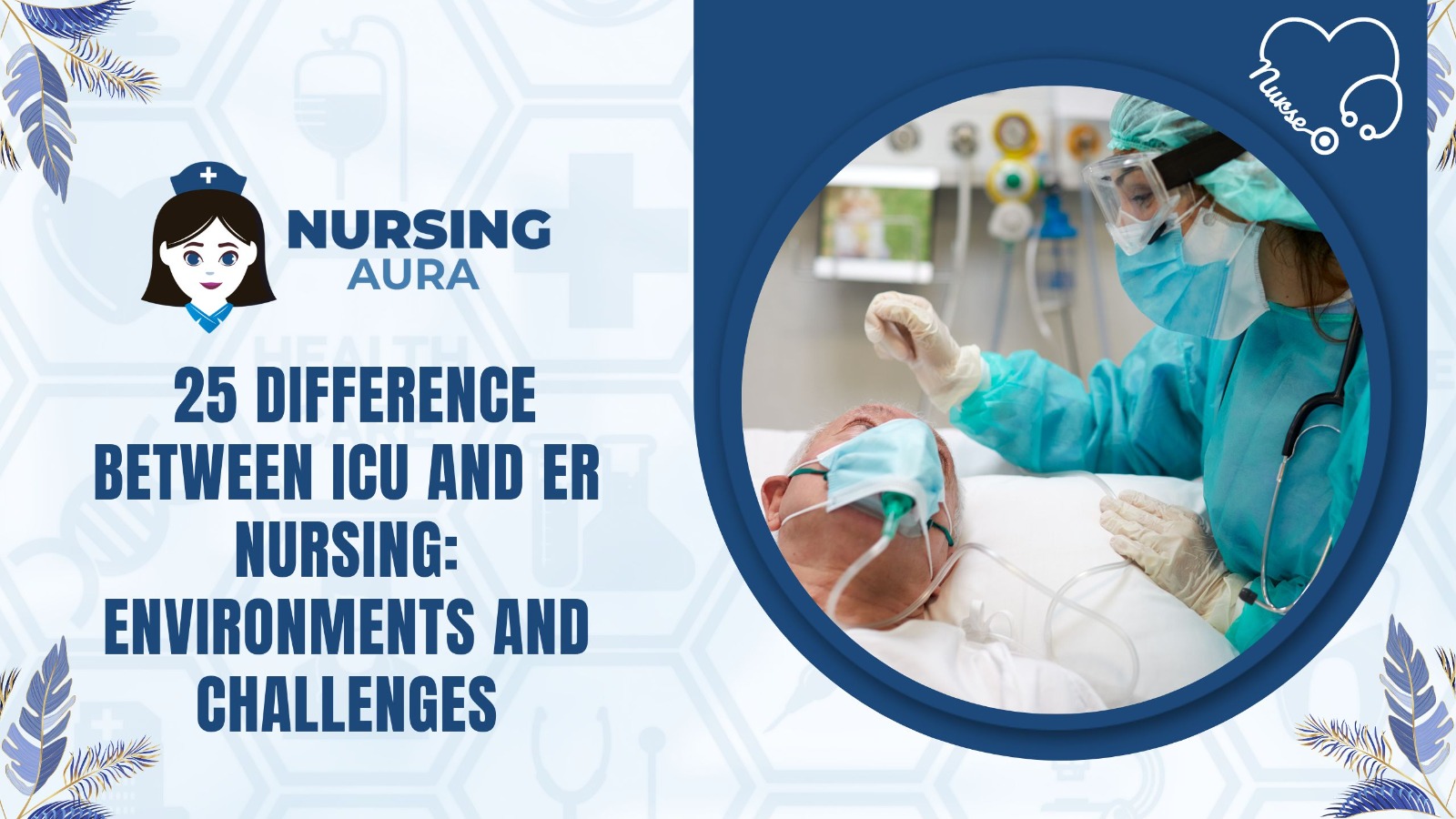In healthcare, ICU and ER nurses have different surroundings and problems. Critically sick patients get extensive medical treatment in ICUs. ER nursing responds to and stabilizes patients experiencing medical crises. Clinical settings vary substantially for these nurses. The severe circumstances of ICU patients necessitate continual monitoring, sophisticated life support, and specific treatments from nurses. Contrarily, ER nurses handle trauma, cardiac events, and respiratory distress in a fast-paced, unpredictable setting.
ICU and ER nurses face many different obstacles. Chronically sick ICU patients require long-term care and emotional support from nurses and their families. They efficiently understand complex medical data and work with diverse teams. ER, nurses triage patients quickly and intervene to stabilize conditions, thus they are good at fast evaluation and decision-making. While dealing with emotional and stressful emergency situations, they must be calm.
ICU nurses typically form long-term connections with patients, attending to their rehabilitation or, in some circumstances, their demise. The right technical skills and emotional resilience are needed. The unpredictability of arriving patients requires ER nurses to think quickly and alter emphasis. whereas both positions demand good communication skills, ICU nurses focus on teamwork, whereas ER nurses work with other medical experts to stabilize patients.
ER and ICU nursing have different difficulties and situations. ICU nurses treat severely sick patients in restricted environments, whereas ER nurses promptly respond and stabilize various crises. The critical but diverse responsibilities of ICU and ER nurses in healthcare need outstanding abilities, perseverance, and a dedication to patient-centered care.
| S.No. | Aspect | ICU Nursing | ER Nursing |
| 1 | Patient Population | Critically ill patients requiring intensive care | Patients with a wide range of urgent medical issues |
| 2 | Setting | Specialized unit within a hospital | Emergency department of a hospital |
| 3 | Patient Stability | Less stable with life-threatening conditions | Variable stability, but generally less critical |
| 4 | Nurse-to-Patient Ratio | Lower ratios, often 1:1 or 1:2 | Higher ratios, can vary but may be 1:4 or more |
| 5 | Specialization | Specialization in specific ICU types (e.g., medical, surgical) | Broad range of cases, from trauma to minor injuries |
| 6 | Duration of Care | Longer duration of patient stays (days to weeks) | Shorter duration, patients are either admitted or discharged |
| 7 | Technology | Extensive use of advanced monitoring and life support equipment | Use of basic and some specialized equipment |
| 8 | Medical Interventions | Administer complex medications and treatments | Focus on rapid assessment, stabilization, and initial treatment |
| 9 | Continuity of Care | Provide ongoing care, witness patient’s condition progression | Initial care, with patient transfer or disposition |
| 10 | Team Collaboration | Collaborate with multidisciplinary teams including physicians, RTs, pharmacists | Collaborate with various specialties, including surgeons |
| 11 | Emotional Challenges | Coping with high mortality rates and long-term illness | Deal with high-pressure situations, trauma, and unpredictability |
| 12 | Focus of Care | Stabilization, prevention of complications | Rapid assessment, initiation of treatment, and disposition |
| 13 | Family Involvement | Involve families in care decisions, provide emotional support | Limited involvement due to the acute nature of care |
| 14 | Shift Length | Typically 12-hour shifts or longer | Variable shift lengths, often 8-12 hours |
| 15 | Critical Thinking | Constant critical thinking, complex decision-making | Quick decision-making, handling diverse cases rapidly |
| 16 | Documentation | Detailed documentation of patients’ conditions and treatments | Quick and concise documentation of ER interventions |
| 17 | Stress Levels | High stress due to the severity of patient conditions | High stress due to the fast-paced, unpredictable environment |
| 18 | Training and Education | Specialized training in critical care nursing | General emergency nursing training with ongoing education |
| 19 | Admission Process | Admit patients from other units or the ER | Admit patients from the community or transfer from other hospitals |
| 20 | Shift Handovers | Detailed shift handovers to ensure continuity of care | Quick and concise handovers to oncoming nurses |
| 21 | Resources Availability | Access to specialized resources and equipment | Immediate access to necessary resources in the ER |
| 22 | Acuity of Cases | High acuity cases with complex medical conditions | Variable acuity, ranging from minor to life-threatening |
| 23 | Diagnostic Procedures | May involve invasive diagnostic procedures | May initiate diagnostic workup but often refer for specialized tests |
| 24 | Patient Advocacy | Advocate for patients with complex care needs | Advocate for patients’ immediate medical needs |
| 25 | Long-Term vs. Acute Care | Primarily involved in acute care | May be involved in both acute and long-term care |
Frequently Asked Questions (FAQS)
1. How do ICU and ER nursing differ?
The focus and breadth of ICU and ER nursing vary. The monitoring and specialized treatment of critically sick patients with complicated medical issues is ICU nursing. These patients generally need extensive life support. Instead, ER nurses examine and stabilize patients with trauma, cardiac events, and respiratory distress. ER nurses must work quickly to prioritize care and stabilize patients before transferring them to suitable facilities.
2. What are the ICU nurses' challenges?
Managing complex medical demands and chronic diseases is difficult for ICU nurses. Interpret complicated medical data, deliver specialist therapies, and work with a multidisciplinary healthcare team. ICU nurses typically form personal bonds with patients and their families, seeing their recovery or end-of-life care. Emotional resilience, understanding, and medical and emotional assistance are needed.
3. Which skills do ER nurses need?
The fast-paced, unpredictable situation requires particular talents from ER nurses. They must be quick to analyze, make decisions, and prioritize care depending on patient severity. ER nurses must communicate with doctors, patients, and families. To handle various emergency patients, ER nurses need adaptability, coolness under pressure, and multitasking.
4. How are ICU and ER nurses' patient relationships?
Critical circumstances demand lengthier stays in the ICU, therefore nurses generally form longer ties with patients. Patients may progress and get continued assistance. ER nurses focus on stabilization and transfer to suitable units before seeing patients. ICU nurses create closer relationships with patients and their families owing to longer care, even though both positions involve empathy and patient-centered care.
5. How does ICU/ER nursing involve teamwork?
In ICU and ER nursing, cooperation is crucial. ICU nurses serve critically sick patients with doctors, respiratory therapists, pharmacists, and others. Interdisciplinary care tackles all aspects of a patient’s disease. In high-stress emergencies where quick treatments are important for patient outcomes, ER nurses interact with experts and communicate well to provide efficient and coordinated care.

